The Importance of Split Toe Booties for Kiteboarding
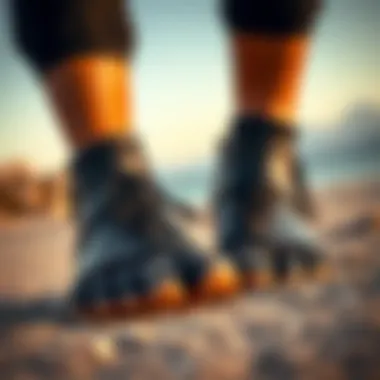
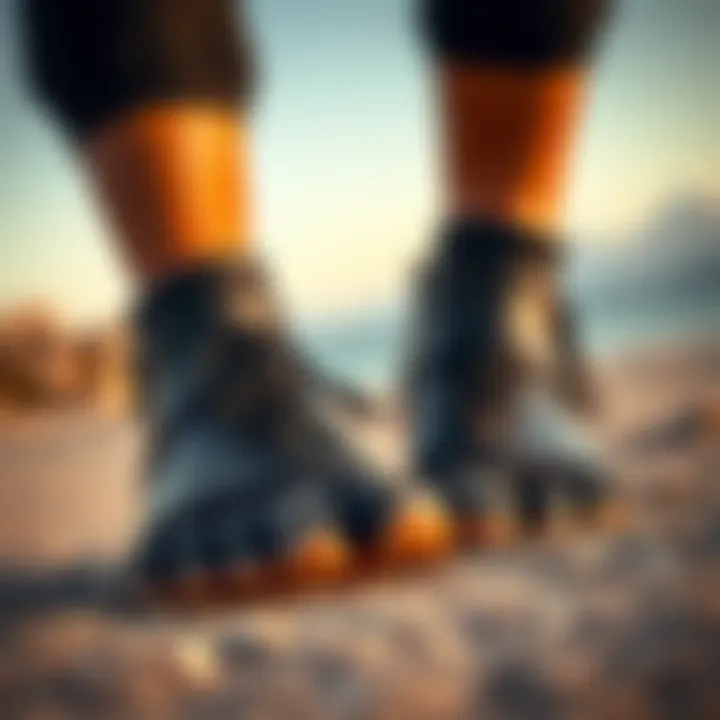
Intro
Kiteboarding is more than just a sport; it's a way of life for those who love the wind and the waves. The right gear can make all the difference in performance, comfort, and safety. Among the critical equipment for any kiteboarder are split toe booties. These unique footwear options provide kiteboarders with enhanced dexterity and grip, essential for mastering this exhilarating water sport. In this exploration, we will unravel the design and functionality of split toe booties, delving into their advantages and technical aspects.
As you navigate through the world of kiteboarding, having the right gear can enhance your overall experience—making every ride on the water more enjoyable and secure. Whether you are just starting your journey or are a seasoned rider, understanding the intricacies of these booties can help you make well-informed purchasing decisions. Let’s jump right in and take a closer look at why split toe booties should be on your list of essentials.
Gear and Equipment
When diving into kiteboarding, the importance of appropriate gear cannot be overstated. Selecting the right equipment lays the groundwork for a successful and fulfilling experience.
Essential Kiteboarding Gear for Beginners
For beginners, keeping it simple is key. Here’s a list of essential items:
- Kite: Choose a kite that matches your skill level and wind conditions.
- Board: A directional board is often recommended for newcomers due to its stability.
- Harness: Look for a comfortable harness that distributes pressure evenly.
- Split Toe Booties: This is where the importance of split toe booties comes into play. They offer increased grip, helping beginners feel more connected to the board.
- Safety Equipment: A helmet and buoyancy vest are must-haves to ensure safety.
Once you have these basics down, you can gradually become more adventurous with your gear.
Advanced Equipment for Experienced Riders
For those who have gained some experience, upgrading your gear can significantly impact performance. Here are a few suggestions:
- High-Performance Kite: Opt for one that provides higher lift and efficiency, complementing advanced techniques.
- Lightweight Board: As you become more skilled, a lightweight board can enhance maneuverability.
- Versatile Harness: Advanced models often provide extra features for added performance.
- Enhanced Split Toe Booties: Look for booties with reinforced areas for durability and better control in rough waters.
Experimenting with advanced equipment will enhance your capabilities and allow you to push your limits on the water.
Techniques and Tips
Kiteboarding is not just about having the right gear; it’s essential to equip yourself with the right knowledge and techniques.
Safety Practices for Kiteboarding
Safety should always be your top priority. Here are some practical points to keep in mind:
- Pre-Flight Check: Inspect your gear before every session to ensure everything is in working order.
- Understand Weather Conditions: Know how to read wind and wave patterns to make informed decisions.
- Buddy System: Always kiteboard with a partner to ensure assistance is readily available.
Training Techniques to Improve Your Skills
To elevate your kiteboarding abilities, consider these training techniques:
- Practice Edging: This helps in maintaining control over the board in varying conditions.
- Jumping Drills: Start with small jumps and gradually increase complexity as you gain confidence.
- Foot Placement: Experiment with foot positioning within your split toe booties to find what works best for you.
Engaging in these techniques can help elevate your kiteboarding experience, whether you’re just starting or have been riding the waves for a while.
"The best kiteboarders are those who never stop learning. Each session is an opportunity to refine your skills and enjoy the adventure further."
End
Split toe booties may seem like a small detail in the grand scheme of kiteboarding, but they play a crucial role in performance and comfort. Embracing the right gear, alongside continuous practice and adherence to safety, will undoubtedly enhance your kiteboarding journey. So, take the plunge, gear up, and savor those exhilarating rides on the water!
For more resources on kiteboarding, check out Wikipedia and join discussions with fellow enthusiasts on Reddit. A deeper understanding of your equipment and techniques will only contribute to the joy of this sport.
Prolusion to Split Toe Booties
When it comes to kiteboarding, having the right gear goes a long way. Among the essentials are the split toe booties, a kind of footwear that can dramatically enhance a rider's experience on the water. These booties not only provide comfort and support but also significantly affect performance and safety. Novice kiteboarders might overlook the importance of foot wear, just as a sailor might underestimate the value of a sturdy anchor. But for the seasoned kiteboarder, every detail counts, from the design of the gear to its material and functionality.
Defining Split Toe Booties
Split toe booties, as the name suggests, feature a design where the big toe is separated from the other four toes. This unique configuration allows for greater sensitivity and connection with the board. Just imagine trying to balance on a surfboard with your foot cramped into a single space – it wouldn't be easy. With split toe booties, every adjustment becomes instinctive, helping riders better control their movements in the water. They often come made from materials like neoprene, which offers flexibility and protection, making them a favorite among both amateurs and pros alike.
Historical Context in Water Sports
The journey of split toe booties in water sports dates back several decades. Initially, when kiteboarding emerged in the late 20th century, surfers and windsurfers adapted existing styles of footwear that were mainly designed for other activities. The need for improved grip and foot control in variable conditions led to the evolution of the split toe design. In the early days, kite surfers often used simple sandals or even bare feet, but it quickly became clear that a more specialized solution was necessary. Over time, as the sport gained popularity, manufacturers began to innovate, leading to the modern-day booties we see today.
These influences from various water sports have shaped the split toe booties into a form that optimizes performance while prioritizing safety. With every advancement in the design, riders can enjoy longer sessions on the water without the worry of discomfort or injuries. In essence, understanding the historical context of these booties provides valuable insight into their necessity and function within kiteboarding.
Design Features
When it comes to split toe booties, the design features play an essential role in the overall functionality and usability of the gear. The unique characteristics not only improve performance but also significantly contribute to comfort, safety, and efficiency on the water. Let's dive into several key aspects that tie into the design of these booties.
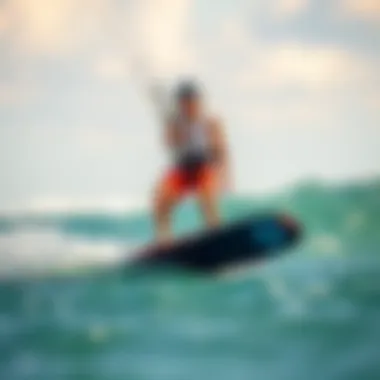
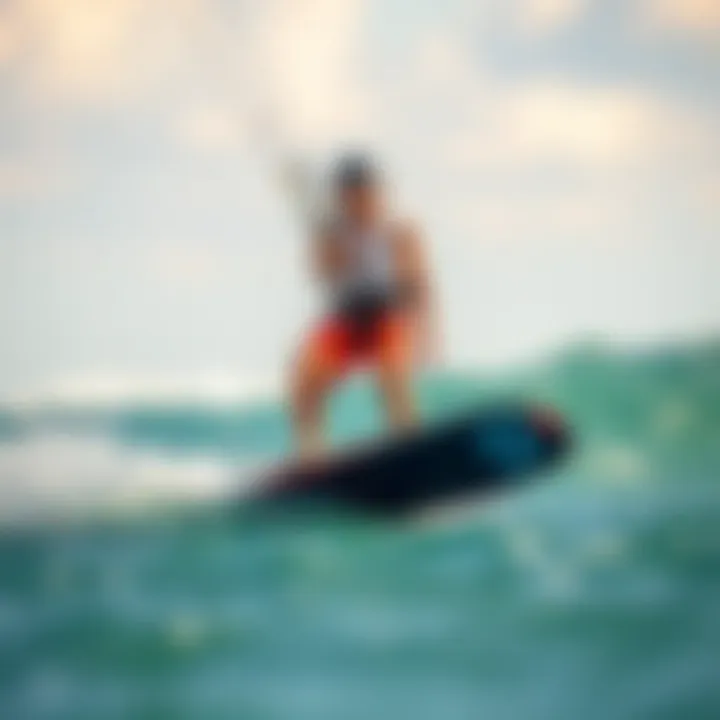
Material Composition
Neoprene Types
Neoprene serves as the backbone of most split toe booties. There are various types of neoprene, each with specific characteristics. The popular ones used in booties include standard, super stretch, and high-grade neoprene. The key aspect of these materials lies in their flexibility and resistance to water. When you slide your foot into a bootie made of high-grade neoprene, you experience a snug fit that feels like a second skin.
Super stretch neoprene, in particular, is a favourite among kiteboarders because it allows for maximal movement without sacrificing warmth. This type of neoprene is not only beneficial for its flexibility, but it also retains heat remarkably well, which is a boon during those chilly sessions at sea. However, booties made from less durable types might not hold up against abrasive surfaces like coral or rocky shores, which is a notable disadvantage.
Durability Considerations
Durability in split toe booties is a crucial consideration as they are often subjected to tough conditions. Booties crafted from reinforced neoprene and featuring robust stitching tend to last longer. The guarding against tears and abrasion is vital when you’re frequently battling the waves. A bootie that wears out sooner than expected can quickly dampen your on-water experience.
Another noteworthy characteristic is the heel and toe reinforcements. These areas are more prone to wear and tear; hence, investing in a pair that boasts solid durability in these spots can save you from frequent replacements. Nevertheless, heavier-duty options might compromise on flexibility, so finding a balance is essential.
Fit and Comfort
Sizing Variations
Sizing is what's often overlooked in the quest for the perfect booties. Split toe designs require a precise fit for optimal comfort and effectiveness. While some brands might run small or large, it’s crucial to trust the diligently crafted size charts that many manufacturers provide. Many have full sizing variations along with half sizes, and this offers an extensive range.
The right fit ensures that your foot doesn’t slide around inside the bootie, which can lead to blisters and discomfort. One common issue among enthusiasts is buying booties a size too big, which creates a loose feeling that doesn't lend well to control on the board. However, finding a snug fit shouldn't come at the expense of comfort either, so trying on various sizes is often necessary before making a purchase.
Arch Support
A well-structured arch support can be the unsung hero of a comfortable kiteboarding experience. Split toe booties that incorporate adequate support in this area help distribute weight evenly across the foot, which can make all the difference during long sessions. If you've ever dealt with foot cramps from poor arch support, you'll understand just how important it is.
Look for models that feature molded footbeds or additional arch cushioning. These elements aid not just in comfort but also in preventing fatigue. When you're standing on a board for extended periods, this becomes vital. However, booties with overbearing arch support may feel restrictive, making it essential to check the fit and feel before committing.
Performance Features
Grip Technology
Grip technology in split toe booties is one of the game-changers for kiteboarders. Advanced grip soles can make the difference between staying upright or taking a nose dive into the water. Many booties incorporate specific tread patterns that are designed to provide traction even on wet surfaces. This is essential when navigating through choppy waters or performing tricks.
A strong grip ensures you have better control over your board, making it easier to execute maneuvers without worrying about foot slippage. Some brands even use materials that increase adhesive properties when wet, which can greatly enhance performance. Be mindful, though, that sole thickness can compromise feel, so it's key to strike a balance based on the kind of riding you intend to do.
Thermal Insulation
The importance of thermal insulation cannot be underestimated when it comes to split toe booties. Many riders venture out into cold waters where maintaining body heat is indispensable. High-quality thermal insulation materials trap heat effectively, allowing you to focus on your ride instead of shivering.
The unique feature here is the ability to maintain warmth without adding too much bulk. Booties that use thermal linings can feel less constrictive, allowing for better maneuverability. Conversely, poorly insulated booties may leave your feet feeling like ice cubes, diminishing your performance. Therefore, while lightweight insulation is ideal, make sure it doesn’t sacrifice warmth.
Benefits of Using Split Toe Booties
When it comes to kiteboarding, the equipment you choose can make or break your experience on the water. One of the unsung heroes in this realm are split toe booties. These particular booties are not just a fashion statement; they play a crucial role in enhancing performance, comfort, and safety. With the wind whipping around, and waves crashing beneath you, having the right footwear can mean you stay upright or take a tumble, potentially ruining your adventure on the water. So let's dive into the specific benefits of these booties, and see why they’re vital for enthusiasts.
Enhanced Performance
Foot Control
One major benefit of split toe booties is the level of foot control they provide. The design allows your big toe to be separate from the rest of your toes, granting better grip and sensitivity to the board beneath you. This distinction makes it easier to shift your weight and adjust your stance, which is vital when you are riding waves or performing tricks.
When you're kiteboarding, every little movement counts. You want to have a foot feel with your board, so you can react quickly. The split design fosters a precise connection with the board, leading to heightened responsiveness. Kiteboarders who value performance typically find this characteristic appealing because it translates into smoother rides and better maneuverability. If you want to feel in control, split toe booties might just be your ticket.
Stability in Varied Conditions
Now, when the weather turns, say, a bit rougher than expected, stability is of utmost importance. Split toe booties excel in providing stability even when conditions get choppy. The snug fit and specialized shape minimize foot slippage inside the boot, ensuring that your footing remains firm, regardless of how wild the ride gets.
In stormy weather or while navigating turbulent waters, your confidence can take a hit. However, split toe booties help in maintaining that steady footing, making them a popular option among many advanced kiteboarders. The unique aspect of being able to grip more effectively in challenging conditions adds a layer of security that is not easily found in traditional designs. Staying stable while you battle against gusts can make the experience both safer and more exhilarating.
Comfort on the Water
Reduced Chafing
Nobody wants to deal with sore spots while out on the water, and that’s where the reduced chafing aspect of split toe booties comes into play. Because of their construction and fit, they tend to rub less against the skin compared to standard full toe designs. Duplication of material in the toe area can lead to friction, but the split toe design alleviates this.
This feature becomes significant during long sessions in the water, where irritation can lead to distractions and even ruin the fun. Ensuring that your feet are comfortable means you can focus solely on enjoying the ride. This leads many enthusiasts to swear by split toe booties, particularly for extended outings or competitive events.
Temperature Regulation
The functionality of temperature regulation is another core benefit. The materials typically used in split toe booties—like neoprene—are often crafted to maintain body heat, an essential characteristic during those chilly days on the water. Neoprene insulates well while allowing moisture to escape, which keeps feet dry.


If your feet are freezing, forget about being in the zone; your performance will surely suffer. The design helps to maintain thermal balance, making split toe booties a beneficial option for those who kiteboard in various weather conditions. Nobody wants to be the rider whose toes are literally numb.
Safety Measures
Protection Against Cuts
Let’s not sugarcoat it; kiteboarding can be a dangerous sport. Sharp objects in the water, like shells or rocks, pose a threat to unprotected feet. One of the vital benefits of split toe booties is their protection against cuts. They generally feature reinforced soles and a snug fit that grants additional security to the foot, which is essential for safety.
This distinct characteristic makes them a favorite among riders, especially in locations where the waters are littered with hazards. Not having to worry about potential injuries lets you focus your energy on enjoying the ride.
Improved Traction
Another significant aspect is improved traction. Split toe booties can often provide better grip on the surfboard due to their innovative sole designs. Some models come equipped with specific traction patterns or materials that enhance contact with the board, ensuring you’re not slipping and sliding around as you ride.
This feature is not just a small perk; it’s a game-changer for many. Improved traction translates into greater control, which can be the difference between completing a trick or face-planting into the waves. Therefore, when considering what to wear, opting for booties that elevate control and reduce the slip can only do good for your kiteboarding experience.
Selecting the Right Split Toe Booties
Choosing the right split toe booties is fundamental for kiteboarding enthusiasts. It's not just about what looks good; the right pair can significantly impact performance, comfort, and safety on the water. Understanding specific elements like water temperature, foot shape, and key specifications helps in picking the booties that fit best. This choice can make the difference between gliding smoothly over the waves and struggling to maintain balance. It's essential to assess not only your preferences but also factors that will ensure an optimal experience.
Assessing Your Requirements
Water Temperature Considerations
Water temperature is a major factor when selecting your booties. Different temperatures demand different types of insulation in your footgear. In warmer waters, you might prefer thinner materials that keep your feet cooler, while in colder climates, a thicker neoprene bootie is often a preferred choice to maintain warmth.
- Key Characteristic: Adequate insulation.
These considerations ensure that your feet remain comfortable, which directly correlates with your overall performance. If the booties are too thin for the conditions, you could find yourself shivering, which takes your focus away from the sport. - Unique Feature: Extended usage.
Split toe booties designed with water temperature in mind can often cater to specific climates, giving you the edge whether you’re riding in balmy or chilly conditions.
Foot Shape and Size
Understanding your own foot shape and size is just as crucial. Everyone has a unique structure, and it's essential to find booties that accommodate your specific needs, ensuring a snug fit without compromising comfort.
- Key Characteristic: Snug fit.
Booties that fit correctly allow for better control when maneuvering your board, enhancing your overall kiteboarding experience. If they are too tight or too loose, the result can be a lack of balance, leading to mishaps. - Unique Feature: Adjustability.
Look for designs that offer adjustability or those that come in various widths and sizes to ensure you find just the right fit for your own unique foot shape.
Key Specifications to Consider
When delving into the specific features of split toe booties, there are two aspects that truly stand out: thickness and flexibility, as well as seam construction. Both play a pivotal role in the durability and functionality of your gear.
Thickness and Flexibility
The thickness of booties directly affects their performance and comfort level. Thin booties provide a close feel to the board, allowing for better responsiveness, while thicker boots enhance insulation and protection can be vital when navigating rocky or debris-laden waters.
- Key Characteristic: Balance between insulation and responsiveness.
Choosing the right thickness means juggling warmth against the control and sensitivity needed for precise navigation. Many riders find that a middle ground works best for different conditions. - Unique Feature: Customizable options.
Some manufacturers provide variations in bootie thickness, which allows you to select a pair that fits the specific needs of your environment, whether you need more flexibility or enhanced protection.
Seam Construction
Seam construction is another essential specification to consider. Different methods of seam joining can affect the longevity and waterproofing of your booties. Flatlock seams, for instance, are popular because they lay flat and reduce the risk of chafing.
- Key Characteristic: Durability and comfort.
Proper seam construction leads to more durable booties that withstand the rigors of kiteboarding. Strong seams are necessary, especially when faced with high-stress situations. - Unique Feature: Minimal water entry.
A well-constructed seam reduces water entry, keeping your feet dry and warm, which can enhance your enjoyment and efficacy on the water.
Selecting the right split toe booties involves a careful assessment of your needs and the features that matter most. This attention to detail can elevate your kiteboarding experience to new heights.
Comparative Analysis: Split Toe vs. Full Toe Booties
Understanding the differences between split toe and full toe booties is crucial for kiteboarding enthusiasts. Each design offers unique benefits and drawbacks that can significantly affect performance and comfort out on the water. Kiteboarders should consider various aspects, including precision, protection, adaptability, and personal preferences, to make an informed decision. This analysis aims to shed light on these factors and help riders choose the right bootie for their needs.
Performance Aspects
Precision vs. Protection
When it comes to performance, the debate between precision and protection is often at the forefront. Split toe booties provide a certain level of precision that can enhance foot control while riding. The separation of the big toe allows for better grip on the board, which is essential when performing jumps or sharp turns in challenging conditions. This capability makes split toes a preferred option for many serious riders who crave that connection with their equipment.
On the flip side, full toe booties offer more protection. With their design, they cover the entire foot, shielding riders from sharp objects lurking under the water or on the beach. Whether it’s broken shells or stones, full toe booties can be a lifesaver. However, this comes at a cost, as the snugness often lacks the kind of feel a split toe provides. To sum it up, if you prioritize agility and control, split toe might be your go-to. But if you’re the cautious type, full toe could be more your speed.
Adaptability to Conditions
The adaptability of booties to different conditions is another significant factor for kiteboarders. Split toe designs excel in providing flexibility, which helps riders adapt to varying weather conditions and water temperatures. Their fit can cater to a wider range of conditions, making them a solid choice for those who might not stick to one style or location. This ability to stretch and bend means you can often find a sweet spot between comfort and performance.
In contrast, full toe booties tend to have more insulation due to their design, which can be advantageous in colder waters. They are generally thicker and less flexible, which can hamper quick movements. Riders who enjoy year-round kiteboarding may find that full toe options keep their feet warm during colder months but might require some getting used to in terms of less mobility. Each style has its unique features that cater to different rider preferences and environmental demands.
Usage Scenarios
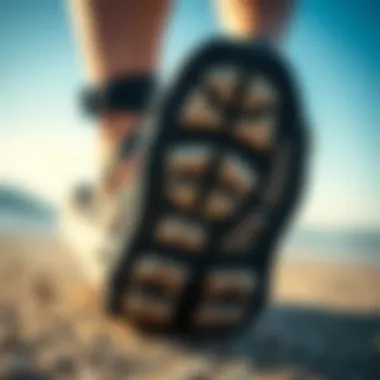
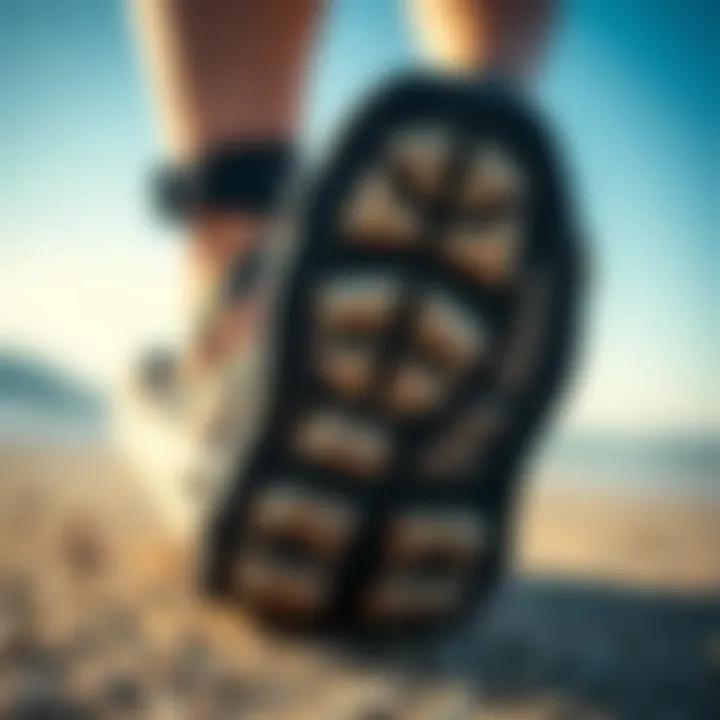
Best Practices in Various Environments
In the kitesurfing world, environment dictates gear choices heavily. For shallow waters or areas filled with sharp sand and debris, full toe booties are often recommended due to their protective design. Riders can enjoy peace of mind knowing they are safe from cuts and scrapes, allowing them to focus entirely on their performance.
On the other hand, split toe booties are a great choice for open sea conditions where maneuverability is key. Riders looking for agility in their movements might opt for them as they navigate through choppy waters. Remember that conditions can change quickly, so knowing the best practices for each environment can significantly enhance your kiteboarding experience.
User Preferences
User preference often plays a large role in the decision between split toe and full toe booties. Some riders prefer the feeling of having their big toe separated, claiming it helps in achieving a better sensation of the board beneath their feet, thus improving their overall performance. Others might find this separation uncomfortable, leaning towards full toe options for the snugness and warmth they provide.
Each choice comes with trade-offs; therefore, it's essential to try on various types to find your ideal fit. Some might even consider owning multiple pairs for different scenarios! Ultimately, user preferences dictate what works best in specific riding situations, so keep that in mind while selecting your booties.
"The right booties can make or break your kiteboarding experience—choose wisely to ride comfortably and confidently!"
Maintenance and Care for Split Toe Booties
Maintaining split toe booties is an essential aspect of ensuring they last through many kiteboarding seasons. After all, these booties are not just a fashion statement; they're a significant piece of gear that supports performance, comfort, and safety on the water. Proper care goes a long way in preserving their functionality, preventing wear and tear, and keeping your feet protected during your adventures.
Cleaning Methods
When you come off the water, the first order of business should be cleaning your split toe booties. Saltwater, sand, and mud are not friends of neoprene. To keep your booties in top shape, follow these cleaning steps:
- Rinse with Fresh Water: As soon as you can, run fresh water over your booties. This helps prevent salt buildup that can degrade the material over time.
- Gentle Scrub: If you notice stubborn dirt or sand, use a soft brush or cloth to gently scrub the affected areas. Avoid using harsh chemicals that could deteriorate the neoprene.
- Air Dry: Let your booties air dry naturally, away from direct sunlight. Hanging them by the toes can help them maintain their shape.
"A little maintenance goes a long way in extending the life of your gear. Don’t let dirt and salt catch you off guard!"
Following these steps helps remove contaminants and keeps the material resilient. Regular cleaning not only protects your investment but also ensures a comfortable fit every time you hit the water.
Storage Tips
Where and how you store your split toe booties is nearly as important as how you clean them. Improper storage can warp materials or invite mold in damp conditions. Here are some tips on storing your booties wisely:
- Dry Completely: Before putting your booties away, make sure they are completely dry. Store them only when there's no moisture, as leftover dampness can cause unpleasant odors and deterioration.
- Keep Them Upright: Store them standing up or hanging. This helps keep the shape of the booties intact, preventing creases or bends that could weaken their structural integrity.
- Avoid Heavy Weight: Don’t stack heavy items on top of them in storage. Pressure on the soft materials can ruin their form.
- Store in a Cool, Dark Place: A closet or storage bin that's away from extreme heat or cold is ideal. Avoid attics or basements that experience temperature swings.
By incorporating these simple cleaning and storage methods into your routine, your split toe booties will be ready for every kiteboarding session, providing the support and safety you need while navigating the waves.
Future Trends in Split Toe Bootie Design
As the kiteboarding industry evolves, so do the accessories that help enthusiasts maximize their experience on the water. Split toe booties are no exception, fitting right into the narrative of innovation. By staying attuned to the latest trends, kiteboarders can make informed selections regarding their gear, ensuring that their booties not only meet their performance needs but also keep up with the cutting-edge advancements in design.
In the world of split toe booties, two primary trends seem to be gaining traction: the incorporation of innovative materials and a redoubled focus on sustainable manufacturing practices. Getting to grips with these trends can offer practical benefits like improved performance, safety, and longevity, that kiteboarders greatly value.
"Staying ahead of gear advancements means better performance on the water and, ultimately, a more enjoyable experience in kiteboarding."
Innovative Materials
The materials used in crafting split toe booties have come a long way in recent years, pushing the envelope on what kiteboarding enthusiasts can expect. Traditional neoprene has been a staple, but now, brands are experimenting by combining it with other high-performance materials. For instance, some manufacturers are incorporating advanced thermoregulating fabrics that manage heat more effectively, providing warmth without sacrificing flexibility. On hot days, you no longer have to deal with the uncomfortable feeling of sweaty feet, thanks to these breathable options.
Additionally, lightweight yet durable fabrics can resist abrasions from sand and sharp objects, extending the lifespan of these booties. Composite materials like Kevlar are increasingly found in regions prone to wear and tear, ensuring that adventurers remain protected regardless of where the currents take them.
A standout trend in this area is the increased popularity of water-repellant coatings that help booties dry faster after a session. Shifting into colder waters is much less of a chore when you know your booties can dry out quickly, preparing you for your next round on the waves.
Sustainable Practices in Manufacturing
The kiteboarding community is becoming ever more conscious of its ecological footprint, and rightly so. Manufacturers are responding with green initiatives that resonate deeply with environmentally aware kiteboarders. Some brands are exploring recycled materials, not just in the booties themselves, but across the entire production line. By doing this, they not only reduce waste but also open new avenues for innovation by finding eco-friendly alternatives to traditional materials.
Furthermore, brands are concentrating on minimizing the emissions related to their manufacturing processes. Factory transparency is becoming a common practice, allowing consumers to make informed decisions about where their gear comes from. This directly influences consumer loyalty, as many are willing to invest in responsibly produced gear even if it comes at a premium price.
Adopting sustainable practices is more than simply a marketing strategy; for many manufacturers, it's a call to action that aligns with the values of today's adventurous, eco-conscious customers. Choosing split toe booties that are manufactured with sustainable practices in mind not only enhances performance but also contributes to the health of the ocean environments they love to play in.
In summary, as the kiteboarding sport evolves, split toe bootie design will likely keep progressing with innovative materials and sustainable practices at the forefront. By staying informed on these trends, enthusiasts can choose products that enhance their experience while also being mindful of the environment.
Epilogue
In navigating the exhilarating world of kiteboarding, the choice of gear significantly influences performance, safety, and enjoyment. Split toe booties stand out as an essential piece of equipment for enthusiasts and professionals alike. They are specifically designed to address the unique challenges faced when conquering the open water, making their understanding paramount for anyone pursuing this dynamic sport.
Recap of Key Insights
Throughout this article, we explored the multifaceted design features of split toe booties, from their specialized materials to the emphasis on comfort and fit. We discussed how performance features like grip technology and thermal insulation play a significant role in enhancing control and stability on the water. The benefits of these booties are vast, improving not only foot control but also providing safety measures such as cut protection and improved traction in varied conditions.
Selecting the right split toe booties involves a careful assessment of personal needs, including water temperature and foot shape. It’s a process that requires consideration of material thickness, flexibility, and the intricacies of seam construction. We also compared split toe booties with full toe options, highlighting their respective advantages dependent on user preferences and specific environmental scenarios.
Final Thoughts on Split Toe Booties
In summary, investing in a solid pair of split toe booties is a decision that can lead to unparalleled experiences on the water. As kiteboarding evolves, so do the materials and designs of these booties, bringing sustainability and innovation to the forefront. Enthusiasts willing to delve into the nuances of this essential gear will find that the benefits outweigh any initial hesitations about trying a new type of equipment.
With the right information and a thoughtful approach to selection, kiteboarders can significantly enhance their enjoyment, safety, and performance on the water. Adapting to individual needs not only secures one’s footing against the waves but can make all the difference between a good day and a great day out on the sea. Ultimately, split toe booties represent much more than just footwear; they are a crucial investment in one’s kiteboarding journey.



